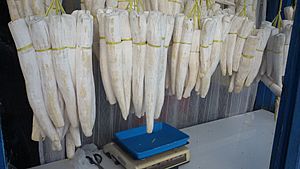Tapai facts for kids
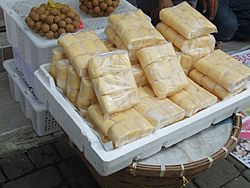
Packaged tapai paste made from cassava in Indonesia
|
|
| Alternative names | Peuyeum, etc. |
|---|---|
| Type | Rice wine, alcoholic paste |
| Region or state | Southeast Asia, East Asia, South Asia |
| Main ingredients | Usually white rice, glutinous rice |
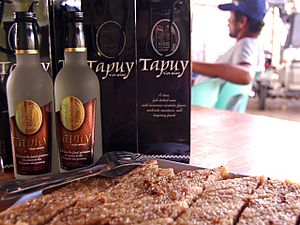
Tapai (also known as tapay or tape) is a special food made by fermentation. This means tiny living things like molds and yeasts change rice or other starchy foods. You can find tapai in many parts of Southeast Asia, especially in cultures with Austronesian roots, and also in parts of East Asia.
Tapai can be a soft, sweet or sour paste, or it can be a drink. People eat it as it is, use it in traditional recipes, or let it ferment even more to make rice wine.
Traditionally, tapai is made from white rice or glutinous rice. But it can also be made from other foods like cassava (also known as yuca) and potatoes. The fermentation process uses different types of molds and yeasts, along with some bacteria.
Contents
What's in a Name? The History of Tapai
The word tapai comes from a very old language called Proto-Malayo-Polynesian. In that language, *tapay meant "fermented food." This word then came from an even older language, Proto-Austronesian, which also used *tapaJ for "fermented food."
Over time, words similar to tapai have been used for many different fermented foods across Austronesia. This includes yeasted bread and rice wine. The word *tapay-an also referred to the large clay jars that were first used for this fermentation process. Today, you can still find similar words like tapayan in Tagalog and tempayan in Javanese.
How is Tapai Made? The Starter Culture
To make tapai, you need to add special tiny living things called microorganisms to a starchy food. These microorganisms come from something called a starter culture. This culture has different names depending on the region.
You can even make this starter culture yourself! People mix rice flour with ground spices like garlic, pepper, chili, and cinnamon. They might also add cane sugar or coconut water, and slices of ginger. This mix is made into a dough and pressed into small, round cakes. These cakes are then left to sit for a few days, often on banana leaves. After that, they are dried and stored until they are ready to be used.
| Region | China | Indonesia/Malaysia | Korea | Philippines | Thailand |
|---|---|---|---|---|---|
| Name | peh-chu, jiuyao (simplified Chinese: 酒药; traditional Chinese: 酒藥; Mandarin Pinyin: jiǔyào; Jyutping: zau2joek1) | ragi tapai | nuruk | bubod, bubur, bubud, budbud, budbod, tapay | look-paeng |
Making Tapai: Traditional and Modern Ways
Traditional Methods
In the past, people would ferment cooked white rice or glutinous rice in large tapayan jars. Depending on how long it fermented and how it was made, tapai could turn into many different things.
For example, it could become a slightly fermented dough used for rice cakes. It could also be dried into fermented cakes, or become fermented cooked rice. Sometimes, rice was fermented with shrimp or fish. Tapai was also used to make various rice wines.
Modern Methods
Fermented Paste
Today, besides rice, other carbohydrate foods like cassava or sweet potatoes can be used to make tapai. The general steps are:
- Wash and cook the food.
- Let it cool down to about 30°C (86°F).
- Mix in some powdered starter culture.
- Let it rest in covered jars for one to two days.
If using cassava or sweet potato, the tubers are washed and peeled before cooking. Then, they are layered in baskets with starter culture sprinkled on each layer. The finished tapai will taste sweet with a hint of alcohol. You can eat it right away, or let it sit for a few more days to become more sour.
| Region | Cambodia | China | India | Indonesia | Korea | Malaysia | Philippines | Singapore | Thailand | Brunei |
|---|---|---|---|---|---|---|---|---|---|---|
| white rice | chao, tapai | lao-chao (Chinese: 醪糟; Mandarin Pinyin: láozāo; Jyutping: lou4zou1), Jiuniang | tapai beras | nuruk | tapai nasi | tapay, buro, balaobalao, balobalo, galapong bigas | tapai nasi | khao-mak | tapai | |
| glutinous rice | tapai | Bhattejaanr | tapai ketan | tapai pulut | tapay, binuburang basi, tapay basi, inuruban, binubudan, binuboran, galapong, galapong malagkit, galapong pilit, galapong salaket | pulut | ||||
| cassava | tapai ketela, tapai ubi kayu (Minangkabau), tape singkong, tape telo, peuyeum (Sundanese) |
tapai ubi kayu | binuburang kamoteng kahoy, binuburang balanghoy, tapay panggi, tapay a banggala |
How Tapai is Used in Cooking
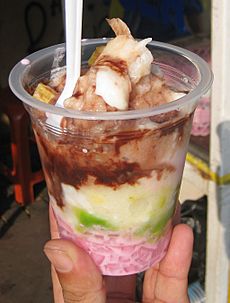
Indonesia
In Indonesia, people often eat tapai as a sweet, slightly alcoholic snack, especially with tea in the afternoon. The sweet fermented tapai is also a key ingredient in many dishes.
For example, Sundanese cassava peuyeum is used to make colenak. This dish is roasted fermented cassava tapai served with kinca, a sweet syrup made from grated coconut and palm sugar. The name colenak is a combination of words that means "tasty dip."
Tapai uli is another dish, made of roasted glutinous rice served with sweet glutinous rice tapai. Peuyeum goreng or tapai goreng (also known as rondho royal in Javanese) is a type of Indonesian fritter. It's made by deep-frying battered cassava tapai.
Tapai, whether from cassava or glutinous rice, is also added to sweet iced desserts like es campur and es doger.
Philippines
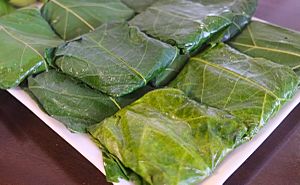
In the Philippines, there are many dishes and drinks made from tapay. Long ago, these were called tinapay, meaning "made through tapay." Today, the word tinapay mostly means "bread" in Filipino languages.
One common use of fermented rice is in galapong. This is a traditional Filipino sticky rice dough. It's made by soaking uncooked glutinous rice overnight (often fermenting it) and then grinding it into a paste. Galapong is the base for many kakanin (rice cakes), like puto and bibingka.
Fermented paste-like tapay is also popular. Different groups have their own versions, such as the Tagalog buro and the Ifugao binuburan. These are often traditionally fermented with or served alongside fish or shrimp. Examples include burong isda and balao-balao.
Rice wines made from tapay include basi from Ilocos and tapuy from Banaue and Mountain Province. Tapuy is actually the final product when binuburan is allowed to ferment completely.
See also
 In Spanish: Tapai para niños
In Spanish: Tapai para niños


